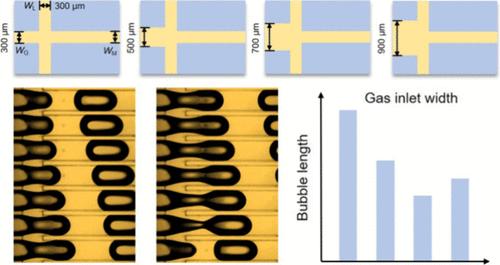当前位置:
X-MOL 学术
›
Ind. Eng. Chem. Res.
›
论文详情
Our official English website, www.x-mol.net, welcomes your
feedback! (Note: you will need to create a separate account there.)
A Gas Kinetic Energy Based Strategy for the Accurate Regulation of Taylor Bubble Length in Flow-Focusing Microchannels
Industrial & Engineering Chemistry Research ( IF 3.8 ) Pub Date : 2024-11-19 , DOI: 10.1021/acs.iecr.4c03426 Lin Sheng, Junjie Wang, Jian Deng, Guangsheng Luo
Industrial & Engineering Chemistry Research ( IF 3.8 ) Pub Date : 2024-11-19 , DOI: 10.1021/acs.iecr.4c03426 Lin Sheng, Junjie Wang, Jian Deng, Guangsheng Luo

|
Accurate regulation of the bubble length determines the microchannel reaction performance, but the existing methods focus on the construction of complex bubble generation structures with high operating requirements. Accordingly, for the flow-focusing microchannel, this study proposes a convenient method that varies the gas inlet kinetic energy to adjust the bubble length. The results show that the gas inlet kinetic energy can be easily regulated by changing the gas channel width, and the bubble size is markedly reduced via expanding the gas channel width, which for the first time breaks the traditional cognition that the bubble size becomes large with the gas inlet width in the T-junction. Besides, the reason behind the formation of smaller bubbles in the flow-focusing with a wider gas channel is jointly revealed by analyzing the two-phase interface behaviors in flow-focusing and T-junction microchannels. Especially, a new variable (the liquid equivalent residence time) is proposed to describe the interaction between the two phases, and the design criterion for the gas inlet size is proposed to reach the minimal bubble length in flow-focusing microchannels. Finally, considering the gas inlet kinetic energy effect, a universal bubble length model containing the ratio of Weber numbers for gas and liquid and capillary number for liquid is developed, which shows its excellent performance for the flow-focusing microchannels used in this work and other studies.
中文翻译:

一种基于气体动能的策略,用于在流聚焦微通道中准确调节泰勒泡长度
气泡长度的精确调节决定了微通道反应性能,但现有方法侧重于构建复杂的气泡发生结构,操作要求高。因此,对于聚焦流道,本研究提出了一种改变进气口动能来调整气泡长度的便捷方法。结果表明,改变气道宽度可以很容易地调节进气口动能,通过扩大气道宽度可以明显减小气泡尺寸,首次打破了T型结中气泡尺寸随进气口宽度变大的传统认知。此外,通过分析流聚焦和 T 型结微通道中的两相界面行为,共同揭示了在具有较宽气体通道的流动聚焦中形成较小气泡的原因。特别是,提出了一个新的变量(液体等效停留时间)来描述两相之间的相互作用,并提出了气体入口尺寸的设计准则,以达到流动聚焦微通道中的最小气泡长度。最后,考虑进气动能效应,建立了包含气液韦伯数与液体毛细管数之比的通用气泡长度模型,该模型在本文和其他研究中使用的聚焦流道中表现出优异的性能。
更新日期:2024-11-19
中文翻译:

一种基于气体动能的策略,用于在流聚焦微通道中准确调节泰勒泡长度
气泡长度的精确调节决定了微通道反应性能,但现有方法侧重于构建复杂的气泡发生结构,操作要求高。因此,对于聚焦流道,本研究提出了一种改变进气口动能来调整气泡长度的便捷方法。结果表明,改变气道宽度可以很容易地调节进气口动能,通过扩大气道宽度可以明显减小气泡尺寸,首次打破了T型结中气泡尺寸随进气口宽度变大的传统认知。此外,通过分析流聚焦和 T 型结微通道中的两相界面行为,共同揭示了在具有较宽气体通道的流动聚焦中形成较小气泡的原因。特别是,提出了一个新的变量(液体等效停留时间)来描述两相之间的相互作用,并提出了气体入口尺寸的设计准则,以达到流动聚焦微通道中的最小气泡长度。最后,考虑进气动能效应,建立了包含气液韦伯数与液体毛细管数之比的通用气泡长度模型,该模型在本文和其他研究中使用的聚焦流道中表现出优异的性能。


















































 京公网安备 11010802027423号
京公网安备 11010802027423号